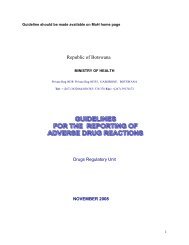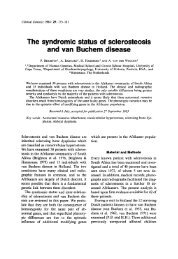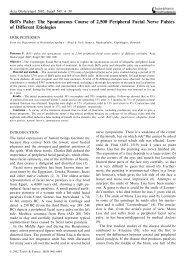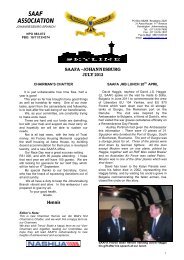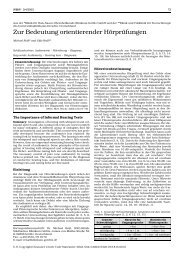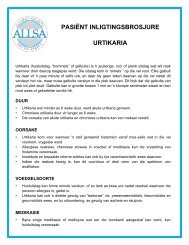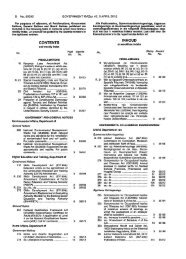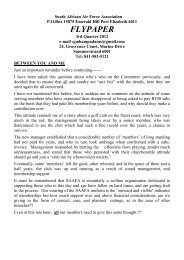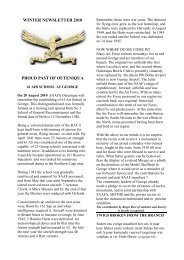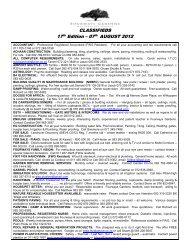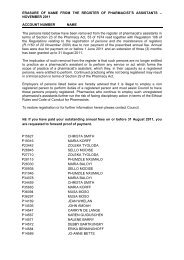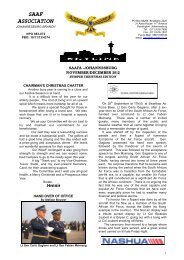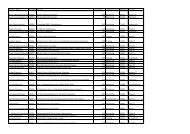Positive Effects of Mime Therapy on Sequelae of Facial Paralysis ...
Positive Effects of Mime Therapy on Sequelae of Facial Paralysis ...
Positive Effects of Mime Therapy on Sequelae of Facial Paralysis ...
You also want an ePaper? Increase the reach of your titles
YUMPU automatically turns print PDFs into web optimized ePapers that Google loves.
Otology & Neurotology<br />
24:677–681 © 2003, Otology & Neurotology, Inc.<br />
<str<strong>on</strong>g>Positive</str<strong>on</strong>g> <str<strong>on</strong>g>Effects</str<strong>on</strong>g> <str<strong>on</strong>g>of</str<strong>on</strong>g> <str<strong>on</strong>g>Mime</str<strong>on</strong>g> <str<strong>on</strong>g>Therapy</str<strong>on</strong>g> <strong>on</strong> <strong>Sequelae</strong> <str<strong>on</strong>g>of</str<strong>on</strong>g><br />
<strong>Facial</strong> <strong>Paralysis</strong>: Stiffness, Lip Mobility, and Social<br />
and Physical Aspects <str<strong>on</strong>g>of</str<strong>on</strong>g> <strong>Facial</strong> Disability<br />
*Carien H. G. Beurskens, and †Peter G. Heymans<br />
*Department <str<strong>on</strong>g>of</str<strong>on</strong>g> Physiotherapy, University Medical Center Nijmegen, Nijmegen, and †Department <str<strong>on</strong>g>of</str<strong>on</strong>g><br />
Developmental Psychology, Utrecht University, Utrecht, The Netherlands<br />
Objective: Evaluati<strong>on</strong> <str<strong>on</strong>g>of</str<strong>on</strong>g> the effect <str<strong>on</strong>g>of</str<strong>on</strong>g> mime therapy, a novel<br />
therapy combining mime and physiotherapy, for patients with<br />
l<strong>on</strong>gstanding (at least 9 m<strong>on</strong>ths) sequelae <str<strong>on</strong>g>of</str<strong>on</strong>g> unilateral peripheral<br />
facial paralysis.<br />
Study Design: Randomized clinical trial, with the treatment<br />
group receiving mime therapy and the c<strong>on</strong>trol group forming a<br />
waiting list.<br />
Setting: Physiotherapy outpatient department <str<strong>on</strong>g>of</str<strong>on</strong>g> two university<br />
medical centers.<br />
Patients: There were 50 patients, 21 men and 29 women, with<br />
sequelae <str<strong>on</strong>g>of</str<strong>on</strong>g> facial paralysis and a mean House-Brackmann<br />
score <str<strong>on</strong>g>of</str<strong>on</strong>g> Grade IV.<br />
Interventi<strong>on</strong>: <str<strong>on</strong>g>Mime</str<strong>on</strong>g> therapy, including automassage, relaxati<strong>on</strong><br />
exercises, inhibiti<strong>on</strong> <str<strong>on</strong>g>of</str<strong>on</strong>g> synkinesis, coordinati<strong>on</strong> exercises,<br />
and emoti<strong>on</strong>al expressi<strong>on</strong> exercises.<br />
Since 1980, mime therapy, a combinati<strong>on</strong> <str<strong>on</strong>g>of</str<strong>on</strong>g> mime and<br />
physiotherapy, has been <str<strong>on</strong>g>of</str<strong>on</strong>g>fered in The Netherlands to<br />
patients with sequelae <str<strong>on</strong>g>of</str<strong>on</strong>g> facial paralysis. Although mime<br />
therapy has shown satisfying results, there is no research<br />
to validate this claim. Many reports document that various<br />
therapies giving good results are used in the treatment<br />
<str<strong>on</strong>g>of</str<strong>on</strong>g> patients with facial paralysis (1). However, few<br />
randomized clinical trials are reported c<strong>on</strong>cerning effects<br />
<str<strong>on</strong>g>of</str<strong>on</strong>g> electromyographic bi<str<strong>on</strong>g>of</str<strong>on</strong>g>eedback in combinati<strong>on</strong> with<br />
exercise therapy (2,3).<br />
The aim <str<strong>on</strong>g>of</str<strong>on</strong>g> mime therapy is to improve symmetry <str<strong>on</strong>g>of</str<strong>on</strong>g><br />
the face both at rest and during movement, simultaneously<br />
c<strong>on</strong>trolling synkineses; in the process, patients<br />
will look and feel better and have less problems with<br />
eating, drinking, speaking, and social integrati<strong>on</strong>. The<br />
treatment c<strong>on</strong>sists <str<strong>on</strong>g>of</str<strong>on</strong>g> a combinati<strong>on</strong> <str<strong>on</strong>g>of</str<strong>on</strong>g> automassage; relaxati<strong>on</strong><br />
exercises; and exercises to inhibit synkineses,<br />
Presented in part at the IX Internati<strong>on</strong>al <strong>Facial</strong> Nerve Symposium,<br />
July 29–August 1, 2001, San Francisco, CA, U.S.A.<br />
Address corresp<strong>on</strong>dence and reprint requests to Carien H. G.<br />
Beurskens, M.D., Department <str<strong>on</strong>g>of</str<strong>on</strong>g> Physiotherapy, University Medical<br />
Center Nijmegen, P.O. Box 9101, 6500 HB Nijmegen, The Netherlands;<br />
Email: c.beurskens@umcn.nl<br />
677<br />
Main Outcome Measures: Stiffness <str<strong>on</strong>g>of</str<strong>on</strong>g> the face, lip mobility<br />
(both lip and pout length) and the physical and social index <str<strong>on</strong>g>of</str<strong>on</strong>g><br />
the <strong>Facial</strong> Disability Index.<br />
Results: Stiffness, lip mobility, and both aspects <str<strong>on</strong>g>of</str<strong>on</strong>g> the <strong>Facial</strong><br />
Disability Index improved substantially because <str<strong>on</strong>g>of</str<strong>on</strong>g> mime<br />
therapy.<br />
C<strong>on</strong>clusi<strong>on</strong>s: On the basis <str<strong>on</strong>g>of</str<strong>on</strong>g> present evidence, mime therapy<br />
is a good treatment choice for patients with sequelae <str<strong>on</strong>g>of</str<strong>on</strong>g> facial<br />
paralysis. Key Words: <strong>Facial</strong> Disability Index—<strong>Facial</strong> paralysis—<str<strong>on</strong>g>Mime</str<strong>on</strong>g><br />
therapy—Physiotherapy—Randomized clinical<br />
trial.<br />
Otol Neurotol 24:677–681, 2003.<br />
enhance facial expressi<strong>on</strong>, and improve functi<strong>on</strong>al movements.<br />
To evaluate the effects <str<strong>on</strong>g>of</str<strong>on</strong>g> mime therapy, a randomized<br />
clinical trial (RCT) was started at the Physiotherapy<br />
Department <str<strong>on</strong>g>of</str<strong>on</strong>g> the University Medical Center<br />
(UMC) in April 1999; patients taking part in this research<br />
project were treated at two centers. The study was<br />
approved by the Advisory Committee <strong>on</strong> Ethics in Human<br />
Experimentati<strong>on</strong> at the UMC. The central questi<strong>on</strong><br />
in this research is, does mime therapy have positive effects<br />
<strong>on</strong> the functi<strong>on</strong>ing (impairment), disability, and<br />
handicap participati<strong>on</strong> level <str<strong>on</strong>g>of</str<strong>on</strong>g> patients with sequelae <str<strong>on</strong>g>of</str<strong>on</strong>g><br />
peripheral facial paralysis (4)? In this report, impairment<br />
is indicated by stiffness and lip mobility or immobility;<br />
disability and handicap are indicated by the physical and<br />
social aspects <str<strong>on</strong>g>of</str<strong>on</strong>g> the <strong>Facial</strong> Disability Index (FDI).<br />
METHODS<br />
Design<br />
The efficacy <str<strong>on</strong>g>of</str<strong>on</strong>g> mime therapy or rehabilitati<strong>on</strong> <str<strong>on</strong>g>of</str<strong>on</strong>g> facial expressi<strong>on</strong><br />
is assessed in a prospective study by comparing two<br />
groups <str<strong>on</strong>g>of</str<strong>on</strong>g> patients randomly assigned to receive mime therapy<br />
(treatment group) or to be <strong>on</strong> a waiting list (c<strong>on</strong>trol group).
678 C. H. G. BEURSKENS AND P. G. HEYMANS<br />
Patient populati<strong>on</strong><br />
Patients with peripheral facial paralysis who were referred to<br />
the physiotherapy departments by the general practiti<strong>on</strong>er; ear,<br />
nose, and throat specialist; plastic surge<strong>on</strong>; or neurologist were<br />
c<strong>on</strong>sidered for the study. The patients had to meet the following<br />
criteria: 18 years or older; unilateral peripheral facial paralysis<br />
existing for at least 9 m<strong>on</strong>ths; no dynamic correcti<strong>on</strong> (nerve or<br />
muscle rec<strong>on</strong>structi<strong>on</strong>); absence <str<strong>on</strong>g>of</str<strong>on</strong>g> complete, partial, or central<br />
facial paralysis; absence <str<strong>on</strong>g>of</str<strong>on</strong>g> c<strong>on</strong>genital facial paralysis; and sufficient<br />
knowledge <str<strong>on</strong>g>of</str<strong>on</strong>g> the Dutch language. All patients were<br />
informed by letter about the research project and a written<br />
c<strong>on</strong>sent for participati<strong>on</strong> was requested.<br />
Randomizati<strong>on</strong><br />
Patients who met the inclusi<strong>on</strong> criteria and signed the c<strong>on</strong>sent<br />
letter were randomly assigned to <strong>on</strong>e <str<strong>on</strong>g>of</str<strong>on</strong>g> two groups: the<br />
c<strong>on</strong>trol group, which received no therapy; or the treatment<br />
group, which received mime therapy. Random assignment was<br />
performed within pairs <str<strong>on</strong>g>of</str<strong>on</strong>g> patients as they became available. If<br />
<strong>on</strong>e patient was randomly assigned to the mime therapy group,<br />
the next patient <str<strong>on</strong>g>of</str<strong>on</strong>g> this pair automatically entered the c<strong>on</strong>trol<br />
group and vice versa. For the first patient <str<strong>on</strong>g>of</str<strong>on</strong>g> a pair, an independent<br />
assistant <str<strong>on</strong>g>of</str<strong>on</strong>g> the physiotherapy administrati<strong>on</strong> department<br />
threw a dice.<br />
<str<strong>on</strong>g>Mime</str<strong>on</strong>g> therapy<br />
<str<strong>on</strong>g>Mime</str<strong>on</strong>g> therapy has been developed from the comp<strong>on</strong>ents<br />
mime and physiotherapy in treating patients with sequelae <str<strong>on</strong>g>of</str<strong>on</strong>g><br />
facial paralysis (5). It c<strong>on</strong>sists <str<strong>on</strong>g>of</str<strong>on</strong>g> a combinati<strong>on</strong> <str<strong>on</strong>g>of</str<strong>on</strong>g> stimulati<strong>on</strong><br />
<str<strong>on</strong>g>of</str<strong>on</strong>g> facial emoti<strong>on</strong>al expressi<strong>on</strong> and functi<strong>on</strong>al movements. The<br />
aims <str<strong>on</strong>g>of</str<strong>on</strong>g> the treatment are to promote symmetry <str<strong>on</strong>g>of</str<strong>on</strong>g> the face at<br />
rest and during movement, enabling the patient to c<strong>on</strong>trol synkineses<br />
or mass movements, resulting in better handling <str<strong>on</strong>g>of</str<strong>on</strong>g> the<br />
handicap. In the present research project, the number <str<strong>on</strong>g>of</str<strong>on</strong>g> treatment<br />
sessi<strong>on</strong>s is 10, each weekly sessi<strong>on</strong> lasting approximately<br />
45 minutes. The therapy is composed <str<strong>on</strong>g>of</str<strong>on</strong>g> sequentially structured<br />
exercises to align the two facial halves (to c<strong>on</strong>trol and to reduce<br />
synkineses) and tasks to reintegrate emoti<strong>on</strong>s with expressi<strong>on</strong>s.<br />
Patients have to perform the exercises daily at home, assisted<br />
by a homework manual (6). Besides providing informati<strong>on</strong> c<strong>on</strong>cerning<br />
treatment and prognosis, the therapy c<strong>on</strong>sists <str<strong>on</strong>g>of</str<strong>on</strong>g> automassage<br />
<str<strong>on</strong>g>of</str<strong>on</strong>g> the face and neck; breathing and relaxati<strong>on</strong> exercises;<br />
specific exercises for the face to coordinate both halves<br />
and to decrease synkineses; exercises in lip closure, necessary<br />
for eating, drinking, and rinsing <str<strong>on</strong>g>of</str<strong>on</strong>g> the mouth; letter and word<br />
pr<strong>on</strong>unciati<strong>on</strong> exercises; emoti<strong>on</strong>al expressi<strong>on</strong> exercises; and<br />
guidance in communicati<strong>on</strong> possibilities.<br />
Measurement instruments<br />
Data were collected c<strong>on</strong>cerning the level <str<strong>on</strong>g>of</str<strong>on</strong>g> impairment, disability,<br />
and handicap <str<strong>on</strong>g>of</str<strong>on</strong>g> the patient in pretest and posttest measures<br />
in both the treatment and the c<strong>on</strong>trol groups. At the impairment<br />
level, stiffness and lip mobility or immobility were<br />
measured and disability was indicated by the physical subscale<br />
<str<strong>on</strong>g>of</str<strong>on</strong>g> the FDI, with the social subscale <str<strong>on</strong>g>of</str<strong>on</strong>g> the FDI indicating the<br />
degree <str<strong>on</strong>g>of</str<strong>on</strong>g> handicap.<br />
Stiffness<br />
To measure stiffness <str<strong>on</strong>g>of</str<strong>on</strong>g> the face, patients were asked to<br />
indicate the experienced stiffness <strong>on</strong> a five-point scale (1 � no<br />
stiffness, 5 � very stiff).<br />
Lip mobility or immobility<br />
To assess the functi<strong>on</strong>ing <str<strong>on</strong>g>of</str<strong>on</strong>g> the perioral muscles indicating<br />
mouth mobility, the length <str<strong>on</strong>g>of</str<strong>on</strong>g> the lips can be measured in two<br />
Otology & Neurotology, Vol. 24, No. 4, 2003<br />
ways: pulling the corners <str<strong>on</strong>g>of</str<strong>on</strong>g> the mouth apart as far as possible<br />
and pulling the corners together. Both movements were quantified<br />
by calculating the lip-length (LL) and pout (P) indices<br />
(7,8). Pout is used in this c<strong>on</strong>text as a technical descripti<strong>on</strong> <str<strong>on</strong>g>of</str<strong>on</strong>g><br />
protrusi<strong>on</strong> <str<strong>on</strong>g>of</str<strong>on</strong>g> the lips. Usually the word “pout” suggests an<br />
expressi<strong>on</strong> <str<strong>on</strong>g>of</str<strong>on</strong>g> annoyance or pique. In earlier references, the<br />
term “snout index” has been used. Because the word “snout”<br />
has different c<strong>on</strong>notati<strong>on</strong>s in English as compared with Dutch<br />
and German (the nose <str<strong>on</strong>g>of</str<strong>on</strong>g> an animal as opposed to the mouth),<br />
the term “P index” is used.<br />
The LL index was assessed by the physiotherapist using a<br />
sliding caliper and after a standard protocol proposed by Jansen<br />
et al (7). The LL index indicates the ratio between the intercommissural<br />
distance (ICD) in a resting positi<strong>on</strong> and the ICD<br />
during c<strong>on</strong>tracti<strong>on</strong> <str<strong>on</strong>g>of</str<strong>on</strong>g> the buccinator, risorius, and zygomatic<br />
muscles. Higher scores indicate greater mobility. The P index<br />
indicates the ratio between the ICD in a resting positi<strong>on</strong> and the<br />
ICD during c<strong>on</strong>tracti<strong>on</strong> <str<strong>on</strong>g>of</str<strong>on</strong>g> the orbicular muscle. Jansen et al. (7)<br />
report that interobserver variati<strong>on</strong>s are negligible and intraobserver<br />
variati<strong>on</strong>s are moderate <strong>on</strong> repeated measurements.<br />
FDI questi<strong>on</strong>naire<br />
All patients completed the questi<strong>on</strong>naire (10 items) comprising<br />
the FDI. The FDI is a disease-specific, self-reporting instrument<br />
developed by VanSwearingen and Brach (9) in 1996<br />
for the assessment <str<strong>on</strong>g>of</str<strong>on</strong>g> patients with sequelae <str<strong>on</strong>g>of</str<strong>on</strong>g> facial paralysis.<br />
The FDI results in two indices: the level <str<strong>on</strong>g>of</str<strong>on</strong>g> physical disability<br />
(FDI-physical) and the level <str<strong>on</strong>g>of</str<strong>on</strong>g> social handicap (FDI-social).<br />
Both indices use a 100-point scale, with higher scores indicating<br />
less impairment and less handicap. Research performed by<br />
VanSwearingen and Brach (9) showed that the FDI subscales<br />
produce reliable and valid measurements in patients with sequelae<br />
<str<strong>on</strong>g>of</str<strong>on</strong>g> facial paralysis.<br />
Hypothesis<br />
<str<strong>on</strong>g>Mime</str<strong>on</strong>g> therapy results in improvement in patients with facial<br />
paralysis, indicated by a lower score <strong>on</strong> stiffness and a higher<br />
score <strong>on</strong> lip mobility, FDI-physical, and FDI-social indices.<br />
RESULTS<br />
Patients<br />
Between April 1, 1999, and November 1, 2001, 162<br />
patients were referred to the physiotherapy departments<br />
<str<strong>on</strong>g>of</str<strong>on</strong>g> two university medical centers. Of these 162 patients,<br />
50 (21 men and 29 women, mean House-Brackmann<br />
Grade IV) met the inclusi<strong>on</strong> criteria and c<strong>on</strong>sented (10).<br />
Reas<strong>on</strong>s for not being included were that the patients<br />
were too young, had received nerve or muscle rec<strong>on</strong>structi<strong>on</strong><br />
after complete paralysis, or were referred earlier<br />
than 9 m<strong>on</strong>ths after the <strong>on</strong>set <str<strong>on</strong>g>of</str<strong>on</strong>g> paralysis.<br />
Twenty-five patients received mime therapy for 3<br />
m<strong>on</strong>ths, and the other 25 patients were <strong>on</strong> a waiting list<br />
for 3 m<strong>on</strong>ths. Because waiting lists in Dutch health care<br />
are ubiquitous phenomena, patients accepted this waiting<br />
period.<br />
Details <str<strong>on</strong>g>of</str<strong>on</strong>g> the patient groups are listed in Table 1.<br />
Groups did not differ significantly regarding gender, age,<br />
referral, cause and severity <str<strong>on</strong>g>of</str<strong>on</strong>g> paralysis, affected side,<br />
and the time interval between the paralysis and the referral.<br />
There were two dropouts, <strong>on</strong>e in each group; reas<strong>on</strong>s<br />
for dropping out were not related to the treatment.
MIME THERAPY AND SEQUELAE OF FACIAL PARALYSIS<br />
Analysis<br />
The analysis was performed <strong>on</strong> the basis <str<strong>on</strong>g>of</str<strong>on</strong>g> data <str<strong>on</strong>g>of</str<strong>on</strong>g> 48<br />
patients in several steps.<br />
Analysis step 1: c<strong>on</strong>trol <str<strong>on</strong>g>of</str<strong>on</strong>g> equivalence <str<strong>on</strong>g>of</str<strong>on</strong>g> groups<br />
at pretest<br />
To check the results <str<strong>on</strong>g>of</str<strong>on</strong>g> the random assignment procedure,<br />
the mean scores <str<strong>on</strong>g>of</str<strong>on</strong>g> the experimental and the waiting<br />
list group were compared (two-sided t test). When<br />
the two groups did not show significant differences, they<br />
were c<strong>on</strong>sidered to be equivalent.<br />
C<strong>on</strong>cerning stiffness, the comparis<strong>on</strong> <str<strong>on</strong>g>of</str<strong>on</strong>g> the two<br />
groups at pretest showed that the mean scores did not<br />
differ significantly (t test, p � 0.86). For the LL index,<br />
this comparis<strong>on</strong> <str<strong>on</strong>g>of</str<strong>on</strong>g> the two groups at pretest showed that<br />
the mean LL index scores did not differ significantly (t<br />
TABLE 1. Compositi<strong>on</strong> <str<strong>on</strong>g>of</str<strong>on</strong>g> patient groups<br />
Waiting list <str<strong>on</strong>g>Mime</str<strong>on</strong>g> therapy Sig*<br />
No. 25 25 NS<br />
Gender M, 10; F, 15 M, 11; F, 14 NS<br />
Age, mean<br />
Referred by<br />
43 (SD, 15; range, 20–73) 44 (SD, 14; range 20–66) NS<br />
General practiti<strong>on</strong>er 3 3 NS<br />
ENT specialist 19 19<br />
Plastic surge<strong>on</strong> 1 3<br />
Neurologist<br />
Cause<br />
2 0<br />
Bell 18 16 NS<br />
Acustic neuroma 4 2<br />
Herpes zoster 2 3<br />
Lyme disease 1 0<br />
Trauma 0 3<br />
Operati<strong>on</strong> trauma<br />
Severity <str<strong>on</strong>g>of</str<strong>on</strong>g> paralysis<br />
0 1<br />
†<br />
House-Brackmann 4 (SD, 0.9; range, 2–5) 4 (SD, 0.8; range, 2–5) NS<br />
Time between <strong>on</strong>set and<br />
intake, mean<br />
16 (SD, 9; range, 10–96; modus, 12) 16 (SD, 11; range, 10–480; modus, 12) NS<br />
Affected side Right, 9; left, 16 Right, 13; left, 12 NS<br />
*Significant difference (p < 0.05).<br />
† Measured by the physiotherapist.<br />
M, male; F, female; ENT, ear, nose, and throat; Sig, significant difference; NS, not significant; SD, standard deviati<strong>on</strong>.<br />
test, p � 0.07), similar results were found for the P index<br />
(t test, p � 0.35).<br />
For both FDI indices (FDI-physical and FDI-social),<br />
the comparis<strong>on</strong> <str<strong>on</strong>g>of</str<strong>on</strong>g> the two groups at pretest showed that<br />
both indices did not differ significantly (t test, p � 0.24<br />
and p � 0.37, respectively). Table 2 lists the mean<br />
scores for all indices at pretest in both groups. The<br />
above-reported absence <str<strong>on</strong>g>of</str<strong>on</strong>g> significant differences between<br />
the treatment and the c<strong>on</strong>trol groups does not depend<br />
<strong>on</strong> gender or age <str<strong>on</strong>g>of</str<strong>on</strong>g> the patients (analysis <str<strong>on</strong>g>of</str<strong>on</strong>g> variance,<br />
no significant interacti<strong>on</strong>s).<br />
The results listed in Tables 1 and 2 support the assumpti<strong>on</strong><br />
<str<strong>on</strong>g>of</str<strong>on</strong>g> the equivalence <str<strong>on</strong>g>of</str<strong>on</strong>g> the treatment and waiting<br />
list groups before treatment. This is a prec<strong>on</strong>diti<strong>on</strong> for<br />
attributing an eventual difference at posttest to an effect<br />
<str<strong>on</strong>g>of</str<strong>on</strong>g> mime therapy.<br />
TABLE 2. Mean scores and standard deviati<strong>on</strong> <str<strong>on</strong>g>of</str<strong>on</strong>g> stiffness, lip mobility, and <strong>Facial</strong> Disability Index at pretest and posttest for<br />
patients in the waiting list group and in the mime therapy group (n = 48)<br />
Pretest mean (SD) Posttest mean (SD)<br />
WL MT Sig* WL MT p value<br />
Impairment level<br />
Stiffness 3.68 (0.75) 3.72 (0.84) NS 3.54 (0.66) 2.37 (0.71)
680 C. H. G. BEURSKENS AND P. G. HEYMANS<br />
Analysis step 2: determinati<strong>on</strong> <str<strong>on</strong>g>of</str<strong>on</strong>g> effects<br />
To determine the effects <str<strong>on</strong>g>of</str<strong>on</strong>g> mime therapy, two substeps<br />
were performed: (a) the mean scores at posttest<br />
were inspected to evaluate whether the treatment group<br />
differed in the hypothesized directi<strong>on</strong> from the mean<br />
scores in the waiting list group; (b) <strong>on</strong>ly when this c<strong>on</strong>diti<strong>on</strong><br />
is met does it make sense to use a statistical test to<br />
determine whether this difference is significantly different<br />
from zero (<strong>on</strong>e-sided test). In the case <str<strong>on</strong>g>of</str<strong>on</strong>g> this c<strong>on</strong>diti<strong>on</strong><br />
not being met, the data would already c<strong>on</strong>tradict the<br />
hypothesis <str<strong>on</strong>g>of</str<strong>on</strong>g> a positive effect <str<strong>on</strong>g>of</str<strong>on</strong>g> mime therapy.<br />
Analysis step 2a: c<strong>on</strong>trol <str<strong>on</strong>g>of</str<strong>on</strong>g> data c<strong>on</strong>sistency<br />
with hypothesis<br />
As can be seen from Table 2, all indices at posttest in<br />
the treatment group compared with the waiting list group<br />
show a difference that is c<strong>on</strong>sistent with the hypothesis<br />
<str<strong>on</strong>g>of</str<strong>on</strong>g> positive effects <str<strong>on</strong>g>of</str<strong>on</strong>g> mime therapy for patients with<br />
sequelae <str<strong>on</strong>g>of</str<strong>on</strong>g> facial paralysis (degree <str<strong>on</strong>g>of</str<strong>on</strong>g> stiffness is lower<br />
for the treatment group; the other three indices are<br />
higher).<br />
Analysis step 2b: statistical analysis <str<strong>on</strong>g>of</str<strong>on</strong>g><br />
posttest differences<br />
To determine whether the observed differences at<br />
posttest are statistically significant, <strong>on</strong>e-sided t tests were<br />
performed for each <str<strong>on</strong>g>of</str<strong>on</strong>g> the indices. The results are shown<br />
<strong>on</strong> the right side <str<strong>on</strong>g>of</str<strong>on</strong>g> Table 2. For all indices, patients in the<br />
treatment group score significantly more favorably compared<br />
with the waiting list group.<br />
Analysis step 3: correcti<strong>on</strong> for interpatient differences<br />
To evaluate the effects <str<strong>on</strong>g>of</str<strong>on</strong>g> the treatment more precisely<br />
at posttest, (i.e., without the blur evoked by preexisting<br />
interindividual differences), analyses <str<strong>on</strong>g>of</str<strong>on</strong>g> covariance were<br />
performed <strong>on</strong> all posttest indices, with the corresp<strong>on</strong>ding<br />
pretest score as a covariable. The results are listed in<br />
Table 3.<br />
After statistical correcti<strong>on</strong> for preexisting differences,<br />
significant (p < 0.05) and substantial (Cohen’s d>1.0<br />
(10,11)) effects <str<strong>on</strong>g>of</str<strong>on</strong>g> mime therapy <strong>on</strong> all outcome variables<br />
are listed in Table 3.<br />
Patients also differ in gender and age. To assess the<br />
TABLE 3. <str<strong>on</strong>g>Effects</str<strong>on</strong>g> <str<strong>on</strong>g>of</str<strong>on</strong>g> mime therapy versus waiting list<br />
c<strong>on</strong>diti<strong>on</strong>—Results <str<strong>on</strong>g>of</str<strong>on</strong>g> ANCOVA after correcti<strong>on</strong> for<br />
interpatients differences at pretest (n = 48)<br />
p* Eta 2<br />
Cohen’s d<br />
Impairment level<br />
Stiffness
MIME THERAPY AND SEQUELAE OF FACIAL PARALYSIS<br />
analysis in this mime therapy study will investigate this<br />
hypothesis.<br />
Strength <str<strong>on</strong>g>of</str<strong>on</strong>g> the design<br />
<str<strong>on</strong>g>Positive</str<strong>on</strong>g> effects <str<strong>on</strong>g>of</str<strong>on</strong>g> mime therapy were inferred from<br />
the existence <str<strong>on</strong>g>of</str<strong>on</strong>g> posttest differences between two randomly<br />
assigned groups. Patients in the treatment group<br />
directly entered (after the pretest) a 10-week treatment<br />
program. Patients in the c<strong>on</strong>trol group (after the pretest)<br />
were told that the start <str<strong>on</strong>g>of</str<strong>on</strong>g> their treatment was scheduled<br />
for 3 m<strong>on</strong>ths later. The random assignment procedure<br />
ensured that the groups were equivalent directly after<br />
assignment. The differences between the two groups at<br />
posttest can <strong>on</strong>ly be attributed to differences arising after<br />
assignment. Obviously, receiving mime therapy (or not)<br />
is <strong>on</strong>e <str<strong>on</strong>g>of</str<strong>on</strong>g> the relevant differences, but are there other<br />
factors that are relevant?<br />
Patients were not blinded as to whether they were <strong>on</strong><br />
the waiting list or not and, because waiting lists in the<br />
Dutch health care system are ubiquitous, patients c<strong>on</strong>sidered<br />
this normal. We have no indicati<strong>on</strong>s that patients<br />
in the waiting list group felt disadvantaged, or that patients<br />
in the treatment group felt privileged. Stiffness and<br />
both FDI indices are based <strong>on</strong> patient report: at pretest,<br />
no significant differences between the groups were<br />
found. Physiotherapists performed the lip mobility measurements<br />
and were not blinded to the patient’s group, as<br />
they had to make appointments for the next visit. The<br />
absence <str<strong>on</strong>g>of</str<strong>on</strong>g> group differences in lip mobility at pretest<br />
does not support the hypothesis <str<strong>on</strong>g>of</str<strong>on</strong>g> biased measurements.<br />
We assume that the therapist’s knowledge regarding the<br />
patient’s c<strong>on</strong>diti<strong>on</strong> did not differentially influence the lip<br />
mobility measurements at posttest. In general, physiotherapists<br />
did not have access to the pretest data when<br />
collecting data at posttest.<br />
Sp<strong>on</strong>taneous recovery in the 3 m<strong>on</strong>ths between pretest<br />
and posttest is the same in both groups, because the<br />
groups are formed by random assignment within patient<br />
pairs. Differential patient expectancies in both groups<br />
(part <str<strong>on</strong>g>of</str<strong>on</strong>g> a placebo effect) could be held resp<strong>on</strong>sible for<br />
(part <str<strong>on</strong>g>of</str<strong>on</strong>g>) the observed posttest differences. We c<strong>on</strong>sider<br />
such effects as part <str<strong>on</strong>g>of</str<strong>on</strong>g> the complex set <str<strong>on</strong>g>of</str<strong>on</strong>g> mechanisms<br />
called <strong>on</strong> by mime therapy. Theoretical work has to be<br />
carried out in c<strong>on</strong>juncti<strong>on</strong> with process studies to reveal<br />
which comp<strong>on</strong>ents underlie the positive effects.<br />
In due time, informati<strong>on</strong> will become available <strong>on</strong> facial<br />
symmetry and synkinesis <str<strong>on</strong>g>of</str<strong>on</strong>g> the patients in this trial<br />
and at the 3- and 12- m<strong>on</strong>th follow-up. This informati<strong>on</strong><br />
will be obtained by scoring videotaped facial perfor-<br />
mance, blinded as to treatment group and time <str<strong>on</strong>g>of</str<strong>on</strong>g> measurement.<br />
CONCLUSION<br />
This research shows that mime therapy has positive<br />
and substantial effects <strong>on</strong> four outcome variables corresp<strong>on</strong>ding<br />
to the World Health Organizati<strong>on</strong>’s classificati<strong>on</strong><br />
<str<strong>on</strong>g>of</str<strong>on</strong>g> functi<strong>on</strong>ing, impairment, and handicap. Physiotherapy<br />
(in particular, exercise therapy) when treating<br />
patients with sequelae <str<strong>on</strong>g>of</str<strong>on</strong>g> facial paralysis is not yet evidence<br />
based, and therefore this research could form a<br />
starting point for further development <str<strong>on</strong>g>of</str<strong>on</strong>g> rehabilitati<strong>on</strong><br />
for this group.<br />
Given the substantial size <str<strong>on</strong>g>of</str<strong>on</strong>g> the effects, mime therapy<br />
seems to be an important treatment opti<strong>on</strong> for patients<br />
with sequelae <str<strong>on</strong>g>of</str<strong>on</strong>g> l<strong>on</strong>gstanding peripheral facial paralysis.<br />
REFERENCES<br />
681<br />
1. Beurskens CHG, Oosterh<str<strong>on</strong>g>of</str<strong>on</strong>g> J, Elvers J, et al. The role <str<strong>on</strong>g>of</str<strong>on</strong>g> physical<br />
therapy in patients with facial paralysis: state <str<strong>on</strong>g>of</str<strong>on</strong>g> the art. Eur Arch<br />
Otorhinolaryngol 1994;Dec(Suppl):S125–6.<br />
2. Ross B, Nedzelski JM, Mclean JA. Efficacy <str<strong>on</strong>g>of</str<strong>on</strong>g> feedback training in<br />
l<strong>on</strong>g-standing facial nerve paresis. Laryngoscope 1991;101:<br />
744–50.<br />
3. Segal B, Hunter T, Danys I, et al. Minimizing synkinesis during<br />
rehabilitati<strong>on</strong> <str<strong>on</strong>g>of</str<strong>on</strong>g> the paralyzed face: preliminary assessment <str<strong>on</strong>g>of</str<strong>on</strong>g> a<br />
new small-movement therapy. J Otolaryngol 1995;24:149–53.<br />
4. ICIDH-2: Internati<strong>on</strong>al Classificati<strong>on</strong> <str<strong>on</strong>g>of</str<strong>on</strong>g> Functi<strong>on</strong>ing and Disability.<br />
Beta-2 draft, full versi<strong>on</strong>. Geneva: World Health Organizati<strong>on</strong>,<br />
1999.<br />
5. Beurskens CHG, Burgers-Bots IAL, van Rossum-Herraets MEJ.<br />
Fysiotherapie bij een perifere facialisverlamming. In: Vaes P, Aufdemkampc<br />
G, den Dekker JB, et al, eds. Jaarboek Fysiotherapie/Kinesitherapie.<br />
Houten/Diegem: Bohn Stafleu van Loghum,<br />
1997:98–116.<br />
6. Devriese PP, Beurskens C, Heiningen van I. Rehabilitati<strong>on</strong> <str<strong>on</strong>g>of</str<strong>on</strong>g> <strong>Facial</strong><br />
Expressi<strong>on</strong> by <str<strong>on</strong>g>Mime</str<strong>on</strong>g>. Amsterdam: Huisdrukkerij AZUA, 1998.<br />
7. Jansen C, Jennekens FGI, Wokke JHJ, et al. Lip-length and snout<br />
indices: methods for quantitative assessment <str<strong>on</strong>g>of</str<strong>on</strong>g> peri-oral facial<br />
muscle strength. J Neurol Sci 1990;97:133–42.<br />
8. Jansen C, Devriese PP, Jennekens FGI, et al. Lip-length and snout<br />
indices in Bell’s palsy. Acta Otolaryngol 1991;111:1065–9.<br />
9. VanSwearingen JM, Brach JS. The <strong>Facial</strong> Disability Index: reliability<br />
and validity <str<strong>on</strong>g>of</str<strong>on</strong>g> a disability assessment instrument for disorders<br />
<str<strong>on</strong>g>of</str<strong>on</strong>g> the facial neuromuscular system. Phys Ther 1996;76:<br />
1288–98.<br />
10. House JW, Brackmann DE. <strong>Facial</strong> nerve grading system. Otolaryngol<br />
Head Neck Surg 1985;113:146–7.<br />
11. Cohen J. Statistical Power Analysis for the Behavioral Sciences.<br />
New York: Academic Press, 1977.<br />
12. Beurskens CHG. <str<strong>on</strong>g>Mime</str<strong>on</strong>g> therapy: rehabilitati<strong>on</strong> <str<strong>on</strong>g>of</str<strong>on</strong>g> the facial expressi<strong>on</strong>.<br />
[doctoral thesis]. Nijmegen: University <str<strong>on</strong>g>of</str<strong>on</strong>g> Nijmegen, 2003.<br />
Otology & Neurotology, Vol. 24, No. 4, 2003



